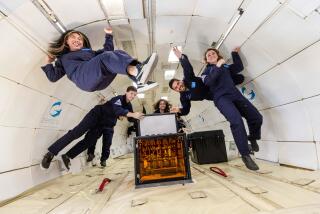Man or Machine? A New Program at UCLA Strives to Put Both Into Space
- Share via
The Columbia tragedy has launched a spirited debate over whether space exploration should continue with men and women or with machines. But the fact is, we will continue to send human beings into the heavens, and a new program at UCLA may help us figure just how far we can go.
On Monday, NASA and the university will debut the Institute for Cell Mimetic Space Exploration, a scientific program for interplanetary research.
The goal of the $35-million, 10-year program is to develop machines for space that mirror the intelligence and adaptability of human beings, says Chih-Ming Ho, the director of the new program and a vice chancellor of research at UCLA. The inspiration for the program arises from the recognition that the cell structure of the human body is an incredibly efficient factory, effortlessly processing information to produce action and reaction.
Seventeen scientists from UCLA’s schools of engineering, medicine and science will collaborate on the program, which will test living cell structures and bioengineered “mimic” cell structures in space three years from now on a specially built satellite being developed at Arizona State University.
Another goal of the program is to learn the workings of human cells in space in hopes of coming up with ways to prevent the crippling loss of bone calcium and muscle power that results from long exposure to weightlessness. In space, humans can lose as much as 10% of bone calcium in a month, a condition that is treatable on today’s missions.
But for the eventual voyages to Mars and other planets, new bioengineered treatments such as the ones being developed at the Cell Mimetic Institute will be needed.
Critics of the U.S. space program argued even before the Columbia accident that many experiments conducted aboard the space shuttle have been “public relations” science. Asked about such criticism, Ho replies adamantly, “that is not the case here; this is the cutting edge.”
NASA is scheduled to put up $30 million and UCLA $5 million for the program. Other federal agencies, including the National Institutes of Health and the Defense Department, have funded research during the last decade that has led up to the Cell Mimetic program.
If the UCLA program is successful, the answer to the manned-unmanned debate will be: both, space exploration by human and intelligent robotic organisms. As professor Carlo Montemagno, co-director of the new program sees it, he and his colleagues are attempting to create “hybrid” machines that will be a bit like “termites.”
“Termites work individually but communicate with each other to build remarkable air-conditioned termite cathedrals,” Montemagno explains. The challenge to the Cell Mimetic Institute will be to work with nano-sensors as small as one-billionth of a human hair to create molecular machines that work like those termites.
The program has attracted an array of big-name aerospace and biotechnology companies, including Raytheon Co., Boeing Co. and Amgen Inc., all of which will be in attendance at Monday’s curtain raising. So will Alfred Mann, the founder of half a dozen biomedical concerns.
They are interested in the program because of the commercial opportunities that have arisen from experiments in space.
Digital imaging and digital communications, for example, began with NASA’s need 30 years ago to send and process pictures from Mars, notes Edward Stone, a Caltech professor and retired head of NASA’s Jet Propulsion Laboratory in Pasadena.
JPL, which will send two unmanned Rover probes to Mars this May, has a program in which companies get help in developing commercial products. Recently, Holoplex Technologies Inc. of Pasadena learned how to use lasers to keep telecommunications signals from degrading over long distances because JPL had learned the technique by doing communications research in space.
At UCLA’s new institute, professor Ho’s work with sensors has instant adaptations to biological warfare and to the search for bacteria in hospital wards. If biological or chemical weapons hazards are suspected in an area, “we can detect the danger with a box of sensors and not have to risk people’s lives,” says Ho, a graduate of National Taiwan University and Johns Hopkins University, who holds seven patents for engineering processes in fluid and micro materials.
But is NASA’s $15.5-billion annual budget needed to discover better ways to detect poison gas or send digital images? Of course not. NASA’s mission is to gain knowledge of the universe and the future of human beings in it. That such missions indirectly produce a wide range of discoveries is the reward a society gets for pursuing knowledge and new capabilities. And that is reason enough to keep going for a U.S. economy that relies increasingly on knowledge work for its livelihood.
*
James Flanigan can be reached at jim.flanigan@
latimes.com.






